Financial Management: Effective Decision Making and Stakeholder Value
VerifiedAdded on 2023/01/11
|19
|5691
|87
Report
AI Summary
This report delves into financial management principles, exploring effective decision-making approaches, stakeholder management, and the value of management accounting in cost control and maximizing shareholder value. It examines techniques for fraud detection and prevention, alongside a ratio analysis of J Sainsbury Plc from 2018 to 2020, assessing data for operational and strategic decisions. The report further discusses investment appraisal techniques, financial decision-making's impact on long-term sustainability, and provides recommendations for improving financial sustainability. It highlights the importance of management accounting practices in making informed business decisions and managing stakeholder conflicts.
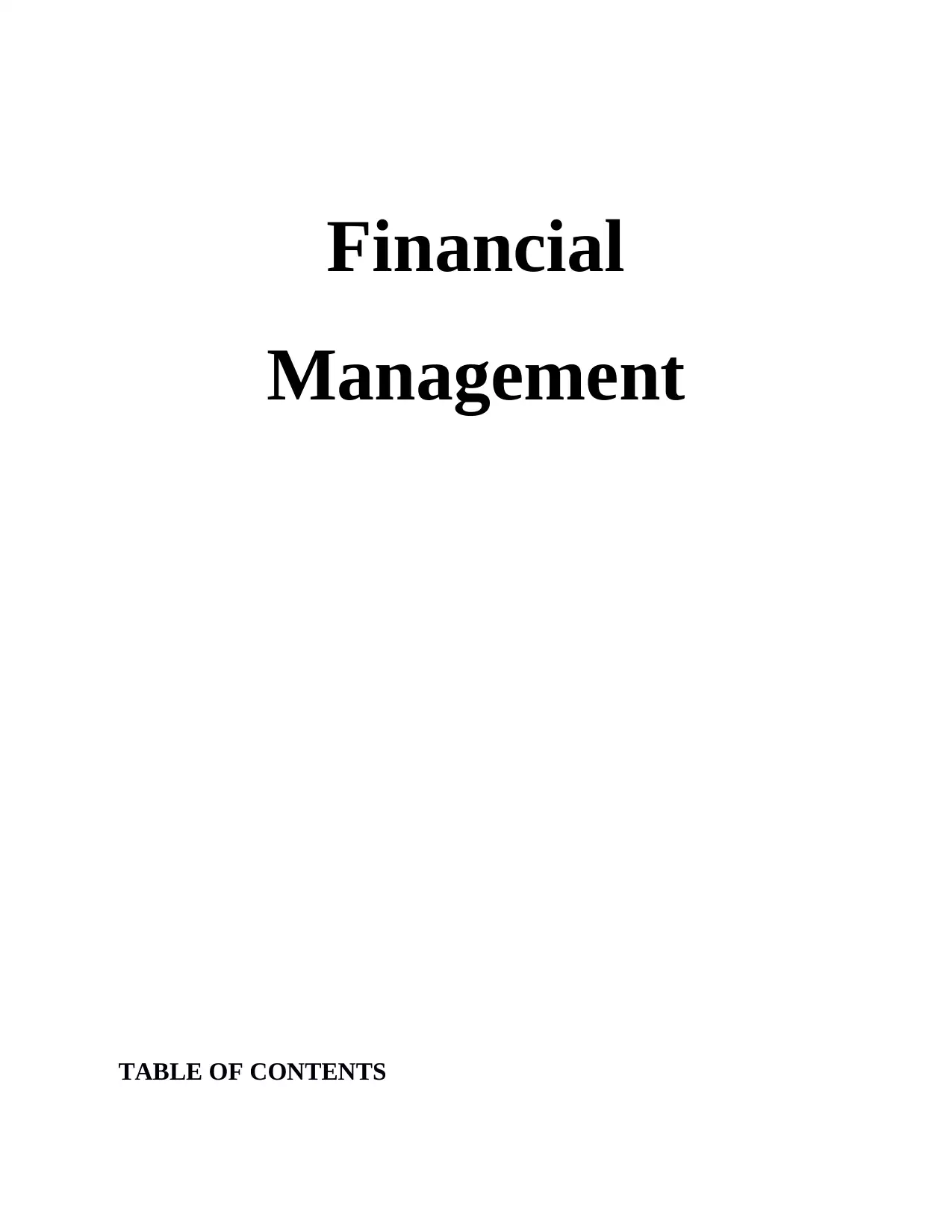
Financial
Management
TABLE OF CONTENTS
Management
TABLE OF CONTENTS
Paraphrase This Document
Need a fresh take? Get an instant paraphrase of this document with our AI Paraphraser
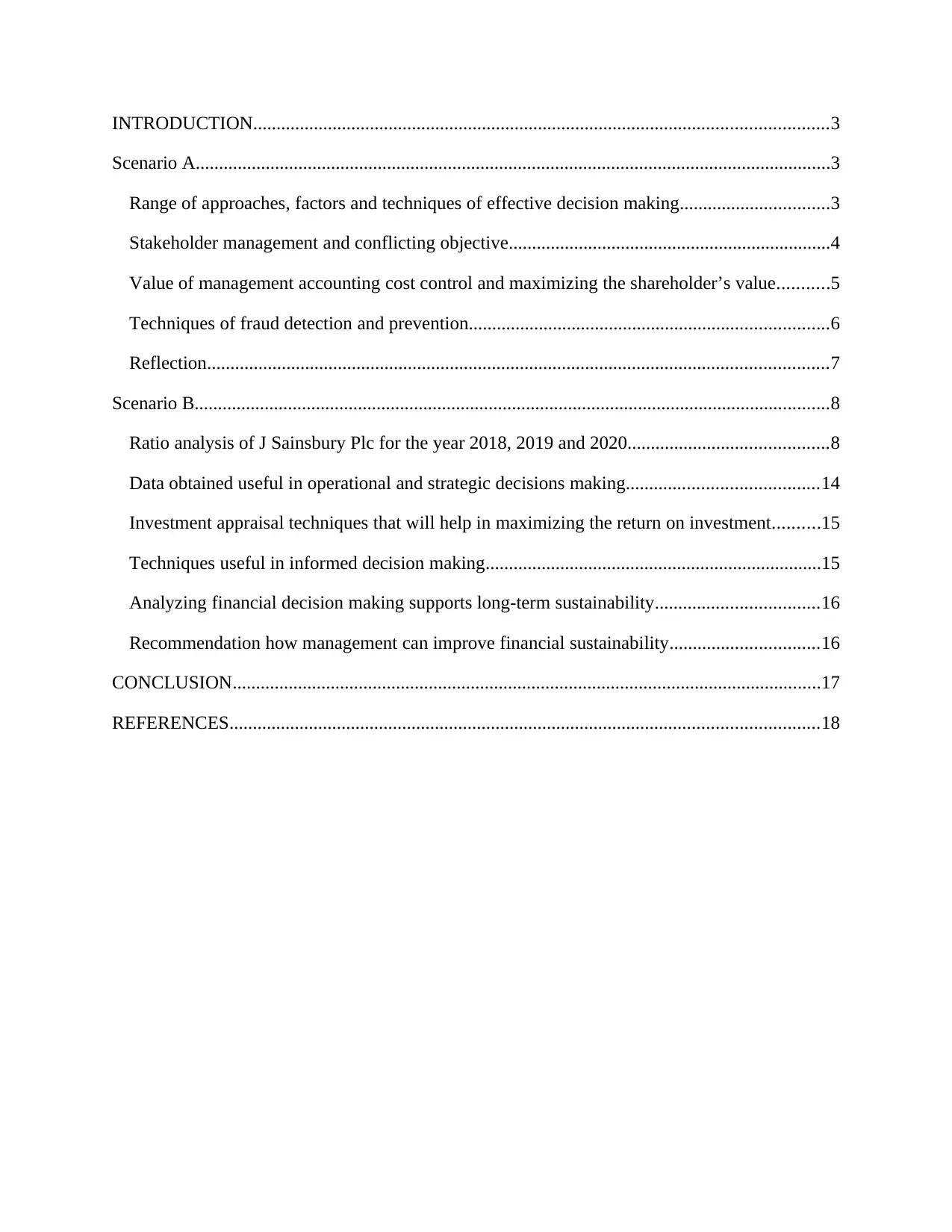
INTRODUCTION...........................................................................................................................3
Scenario A........................................................................................................................................3
Range of approaches, factors and techniques of effective decision making................................3
Stakeholder management and conflicting objective.....................................................................4
Value of management accounting cost control and maximizing the shareholder’s value...........5
Techniques of fraud detection and prevention.............................................................................6
Reflection.....................................................................................................................................7
Scenario B........................................................................................................................................8
Ratio analysis of J Sainsbury Plc for the year 2018, 2019 and 2020...........................................8
Data obtained useful in operational and strategic decisions making.........................................14
Investment appraisal techniques that will help in maximizing the return on investment..........15
Techniques useful in informed decision making........................................................................15
Analyzing financial decision making supports long-term sustainability...................................16
Recommendation how management can improve financial sustainability................................16
CONCLUSION..............................................................................................................................17
REFERENCES..............................................................................................................................18
Scenario A........................................................................................................................................3
Range of approaches, factors and techniques of effective decision making................................3
Stakeholder management and conflicting objective.....................................................................4
Value of management accounting cost control and maximizing the shareholder’s value...........5
Techniques of fraud detection and prevention.............................................................................6
Reflection.....................................................................................................................................7
Scenario B........................................................................................................................................8
Ratio analysis of J Sainsbury Plc for the year 2018, 2019 and 2020...........................................8
Data obtained useful in operational and strategic decisions making.........................................14
Investment appraisal techniques that will help in maximizing the return on investment..........15
Techniques useful in informed decision making........................................................................15
Analyzing financial decision making supports long-term sustainability...................................16
Recommendation how management can improve financial sustainability................................16
CONCLUSION..............................................................................................................................17
REFERENCES..............................................................................................................................18
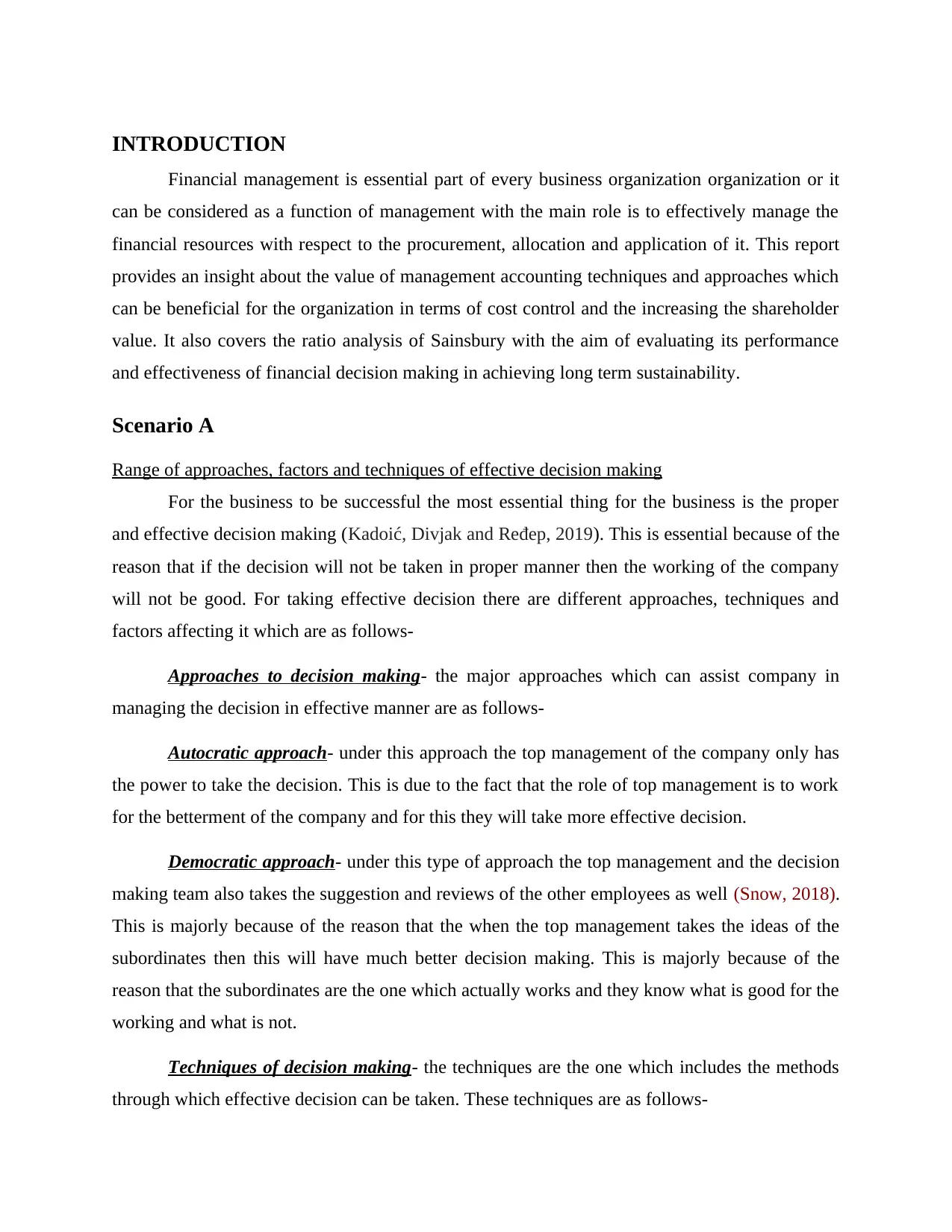
INTRODUCTION
Financial management is essential part of every business organization organization or it
can be considered as a function of management with the main role is to effectively manage the
financial resources with respect to the procurement, allocation and application of it. This report
provides an insight about the value of management accounting techniques and approaches which
can be beneficial for the organization in terms of cost control and the increasing the shareholder
value. It also covers the ratio analysis of Sainsbury with the aim of evaluating its performance
and effectiveness of financial decision making in achieving long term sustainability.
Scenario A
Range of approaches, factors and techniques of effective decision making
For the business to be successful the most essential thing for the business is the proper
and effective decision making (Kadoić, Divjak and Ređep, 2019). This is essential because of the
reason that if the decision will not be taken in proper manner then the working of the company
will not be good. For taking effective decision there are different approaches, techniques and
factors affecting it which are as follows-
Approaches to decision making- the major approaches which can assist company in
managing the decision in effective manner are as follows-
Autocratic approach- under this approach the top management of the company only has
the power to take the decision. This is due to the fact that the role of top management is to work
for the betterment of the company and for this they will take more effective decision.
Democratic approach- under this type of approach the top management and the decision
making team also takes the suggestion and reviews of the other employees as well (Snow, 2018).
This is majorly because of the reason that the when the top management takes the ideas of the
subordinates then this will have much better decision making. This is majorly because of the
reason that the subordinates are the one which actually works and they know what is good for the
working and what is not.
Techniques of decision making- the techniques are the one which includes the methods
through which effective decision can be taken. These techniques are as follows-
Financial management is essential part of every business organization organization or it
can be considered as a function of management with the main role is to effectively manage the
financial resources with respect to the procurement, allocation and application of it. This report
provides an insight about the value of management accounting techniques and approaches which
can be beneficial for the organization in terms of cost control and the increasing the shareholder
value. It also covers the ratio analysis of Sainsbury with the aim of evaluating its performance
and effectiveness of financial decision making in achieving long term sustainability.
Scenario A
Range of approaches, factors and techniques of effective decision making
For the business to be successful the most essential thing for the business is the proper
and effective decision making (Kadoić, Divjak and Ređep, 2019). This is essential because of the
reason that if the decision will not be taken in proper manner then the working of the company
will not be good. For taking effective decision there are different approaches, techniques and
factors affecting it which are as follows-
Approaches to decision making- the major approaches which can assist company in
managing the decision in effective manner are as follows-
Autocratic approach- under this approach the top management of the company only has
the power to take the decision. This is due to the fact that the role of top management is to work
for the betterment of the company and for this they will take more effective decision.
Democratic approach- under this type of approach the top management and the decision
making team also takes the suggestion and reviews of the other employees as well (Snow, 2018).
This is majorly because of the reason that the when the top management takes the ideas of the
subordinates then this will have much better decision making. This is majorly because of the
reason that the subordinates are the one which actually works and they know what is good for the
working and what is not.
Techniques of decision making- the techniques are the one which includes the methods
through which effective decision can be taken. These techniques are as follows-
⊘ This is a preview!⊘
Do you want full access?
Subscribe today to unlock all pages.

Trusted by 1+ million students worldwide
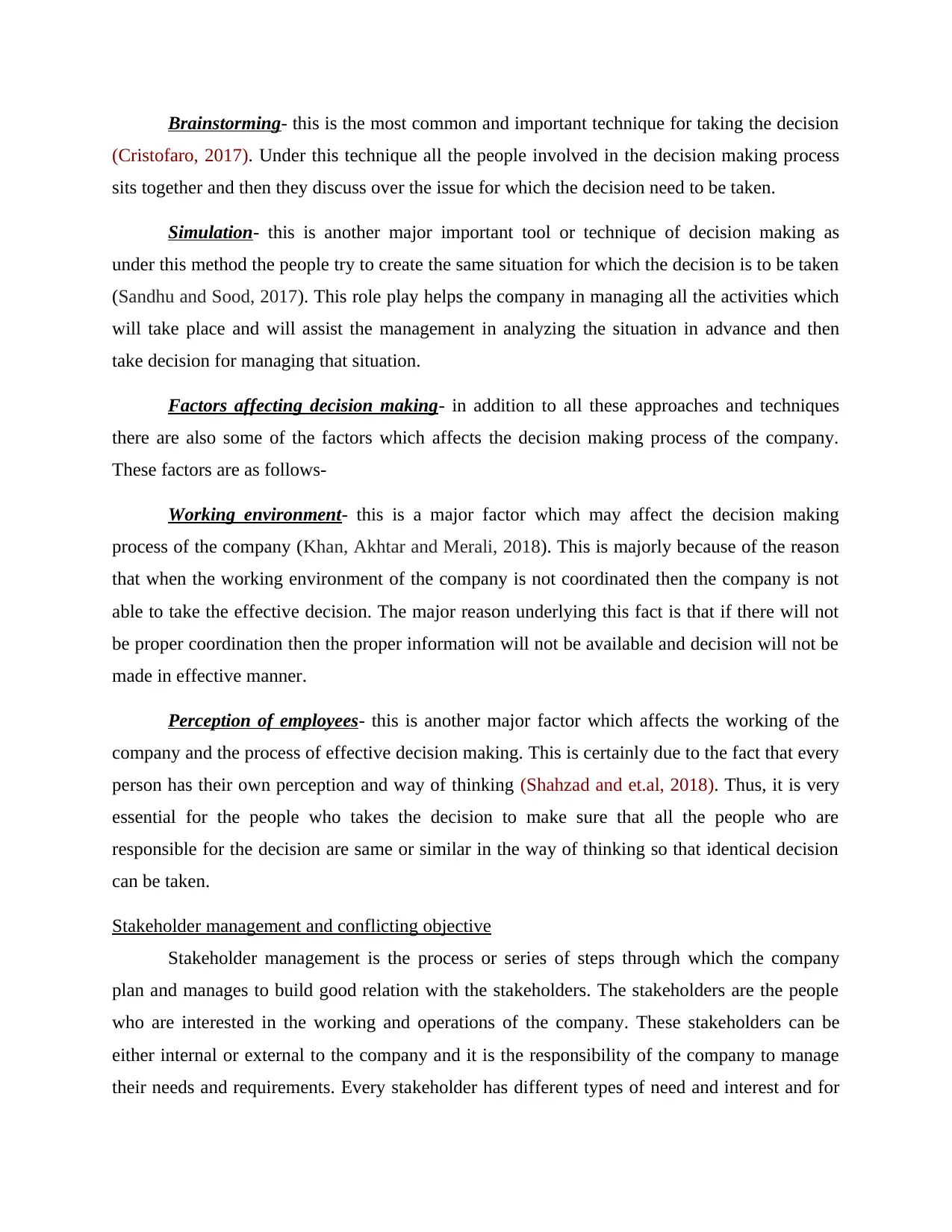
Brainstorming- this is the most common and important technique for taking the decision
(Cristofaro, 2017). Under this technique all the people involved in the decision making process
sits together and then they discuss over the issue for which the decision need to be taken.
Simulation- this is another major important tool or technique of decision making as
under this method the people try to create the same situation for which the decision is to be taken
(Sandhu and Sood, 2017). This role play helps the company in managing all the activities which
will take place and will assist the management in analyzing the situation in advance and then
take decision for managing that situation.
Factors affecting decision making- in addition to all these approaches and techniques
there are also some of the factors which affects the decision making process of the company.
These factors are as follows-
Working environment- this is a major factor which may affect the decision making
process of the company (Khan, Akhtar and Merali, 2018). This is majorly because of the reason
that when the working environment of the company is not coordinated then the company is not
able to take the effective decision. The major reason underlying this fact is that if there will not
be proper coordination then the proper information will not be available and decision will not be
made in effective manner.
Perception of employees- this is another major factor which affects the working of the
company and the process of effective decision making. This is certainly due to the fact that every
person has their own perception and way of thinking (Shahzad and et.al, 2018). Thus, it is very
essential for the people who takes the decision to make sure that all the people who are
responsible for the decision are same or similar in the way of thinking so that identical decision
can be taken.
Stakeholder management and conflicting objective
Stakeholder management is the process or series of steps through which the company
plan and manages to build good relation with the stakeholders. The stakeholders are the people
who are interested in the working and operations of the company. These stakeholders can be
either internal or external to the company and it is the responsibility of the company to manage
their needs and requirements. Every stakeholder has different types of need and interest and for
(Cristofaro, 2017). Under this technique all the people involved in the decision making process
sits together and then they discuss over the issue for which the decision need to be taken.
Simulation- this is another major important tool or technique of decision making as
under this method the people try to create the same situation for which the decision is to be taken
(Sandhu and Sood, 2017). This role play helps the company in managing all the activities which
will take place and will assist the management in analyzing the situation in advance and then
take decision for managing that situation.
Factors affecting decision making- in addition to all these approaches and techniques
there are also some of the factors which affects the decision making process of the company.
These factors are as follows-
Working environment- this is a major factor which may affect the decision making
process of the company (Khan, Akhtar and Merali, 2018). This is majorly because of the reason
that when the working environment of the company is not coordinated then the company is not
able to take the effective decision. The major reason underlying this fact is that if there will not
be proper coordination then the proper information will not be available and decision will not be
made in effective manner.
Perception of employees- this is another major factor which affects the working of the
company and the process of effective decision making. This is certainly due to the fact that every
person has their own perception and way of thinking (Shahzad and et.al, 2018). Thus, it is very
essential for the people who takes the decision to make sure that all the people who are
responsible for the decision are same or similar in the way of thinking so that identical decision
can be taken.
Stakeholder management and conflicting objective
Stakeholder management is the process or series of steps through which the company
plan and manages to build good relation with the stakeholders. The stakeholders are the people
who are interested in the working and operations of the company. These stakeholders can be
either internal or external to the company and it is the responsibility of the company to manage
their needs and requirements. Every stakeholder has different types of need and interest and for
Paraphrase This Document
Need a fresh take? Get an instant paraphrase of this document with our AI Paraphraser
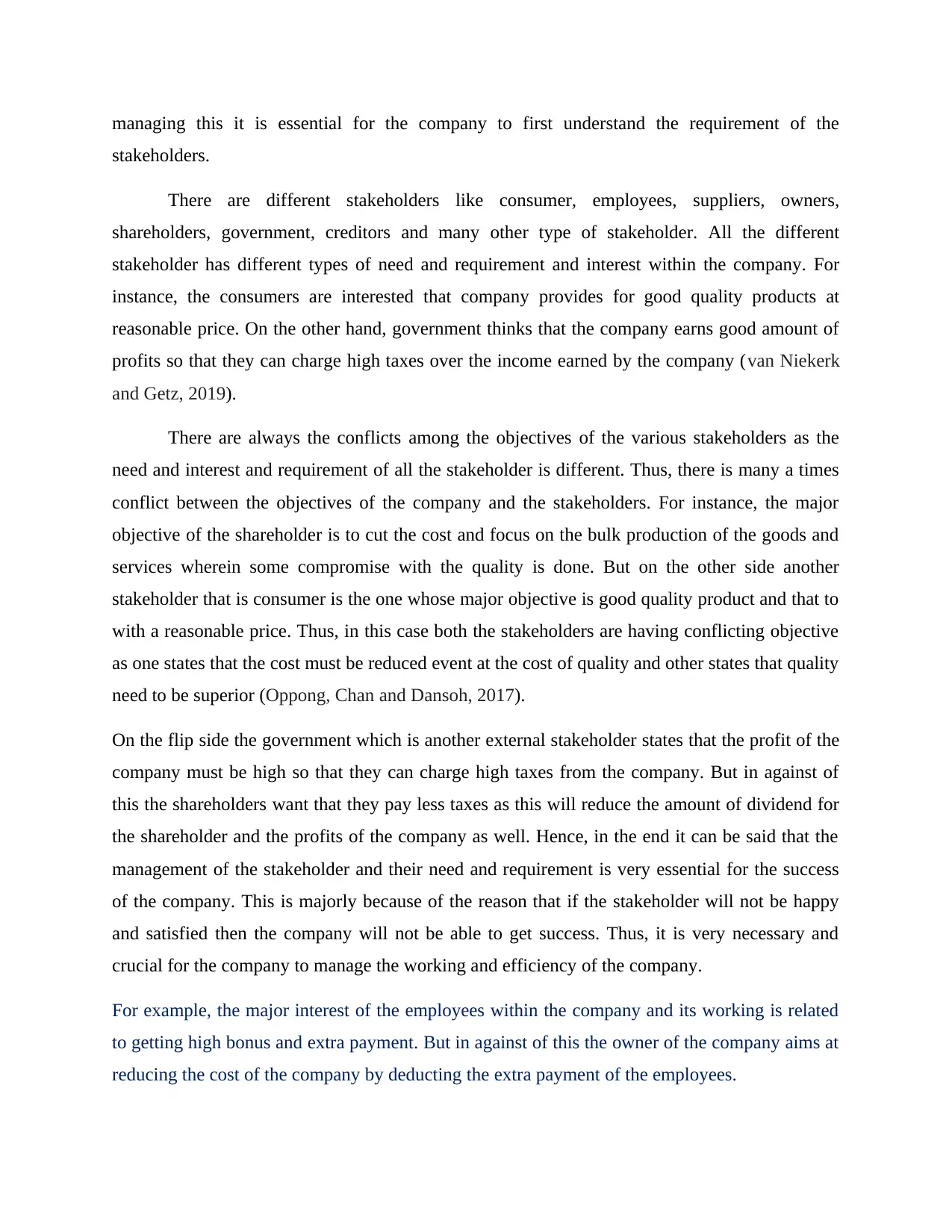
managing this it is essential for the company to first understand the requirement of the
stakeholders.
There are different stakeholders like consumer, employees, suppliers, owners,
shareholders, government, creditors and many other type of stakeholder. All the different
stakeholder has different types of need and requirement and interest within the company. For
instance, the consumers are interested that company provides for good quality products at
reasonable price. On the other hand, government thinks that the company earns good amount of
profits so that they can charge high taxes over the income earned by the company (van Niekerk
and Getz, 2019).
There are always the conflicts among the objectives of the various stakeholders as the
need and interest and requirement of all the stakeholder is different. Thus, there is many a times
conflict between the objectives of the company and the stakeholders. For instance, the major
objective of the shareholder is to cut the cost and focus on the bulk production of the goods and
services wherein some compromise with the quality is done. But on the other side another
stakeholder that is consumer is the one whose major objective is good quality product and that to
with a reasonable price. Thus, in this case both the stakeholders are having conflicting objective
as one states that the cost must be reduced event at the cost of quality and other states that quality
need to be superior (Oppong, Chan and Dansoh, 2017).
On the flip side the government which is another external stakeholder states that the profit of the
company must be high so that they can charge high taxes from the company. But in against of
this the shareholders want that they pay less taxes as this will reduce the amount of dividend for
the shareholder and the profits of the company as well. Hence, in the end it can be said that the
management of the stakeholder and their need and requirement is very essential for the success
of the company. This is majorly because of the reason that if the stakeholder will not be happy
and satisfied then the company will not be able to get success. Thus, it is very necessary and
crucial for the company to manage the working and efficiency of the company.
For example, the major interest of the employees within the company and its working is related
to getting high bonus and extra payment. But in against of this the owner of the company aims at
reducing the cost of the company by deducting the extra payment of the employees.
stakeholders.
There are different stakeholders like consumer, employees, suppliers, owners,
shareholders, government, creditors and many other type of stakeholder. All the different
stakeholder has different types of need and requirement and interest within the company. For
instance, the consumers are interested that company provides for good quality products at
reasonable price. On the other hand, government thinks that the company earns good amount of
profits so that they can charge high taxes over the income earned by the company (van Niekerk
and Getz, 2019).
There are always the conflicts among the objectives of the various stakeholders as the
need and interest and requirement of all the stakeholder is different. Thus, there is many a times
conflict between the objectives of the company and the stakeholders. For instance, the major
objective of the shareholder is to cut the cost and focus on the bulk production of the goods and
services wherein some compromise with the quality is done. But on the other side another
stakeholder that is consumer is the one whose major objective is good quality product and that to
with a reasonable price. Thus, in this case both the stakeholders are having conflicting objective
as one states that the cost must be reduced event at the cost of quality and other states that quality
need to be superior (Oppong, Chan and Dansoh, 2017).
On the flip side the government which is another external stakeholder states that the profit of the
company must be high so that they can charge high taxes from the company. But in against of
this the shareholders want that they pay less taxes as this will reduce the amount of dividend for
the shareholder and the profits of the company as well. Hence, in the end it can be said that the
management of the stakeholder and their need and requirement is very essential for the success
of the company. This is majorly because of the reason that if the stakeholder will not be happy
and satisfied then the company will not be able to get success. Thus, it is very necessary and
crucial for the company to manage the working and efficiency of the company.
For example, the major interest of the employees within the company and its working is related
to getting high bonus and extra payment. But in against of this the owner of the company aims at
reducing the cost of the company by deducting the extra payment of the employees.
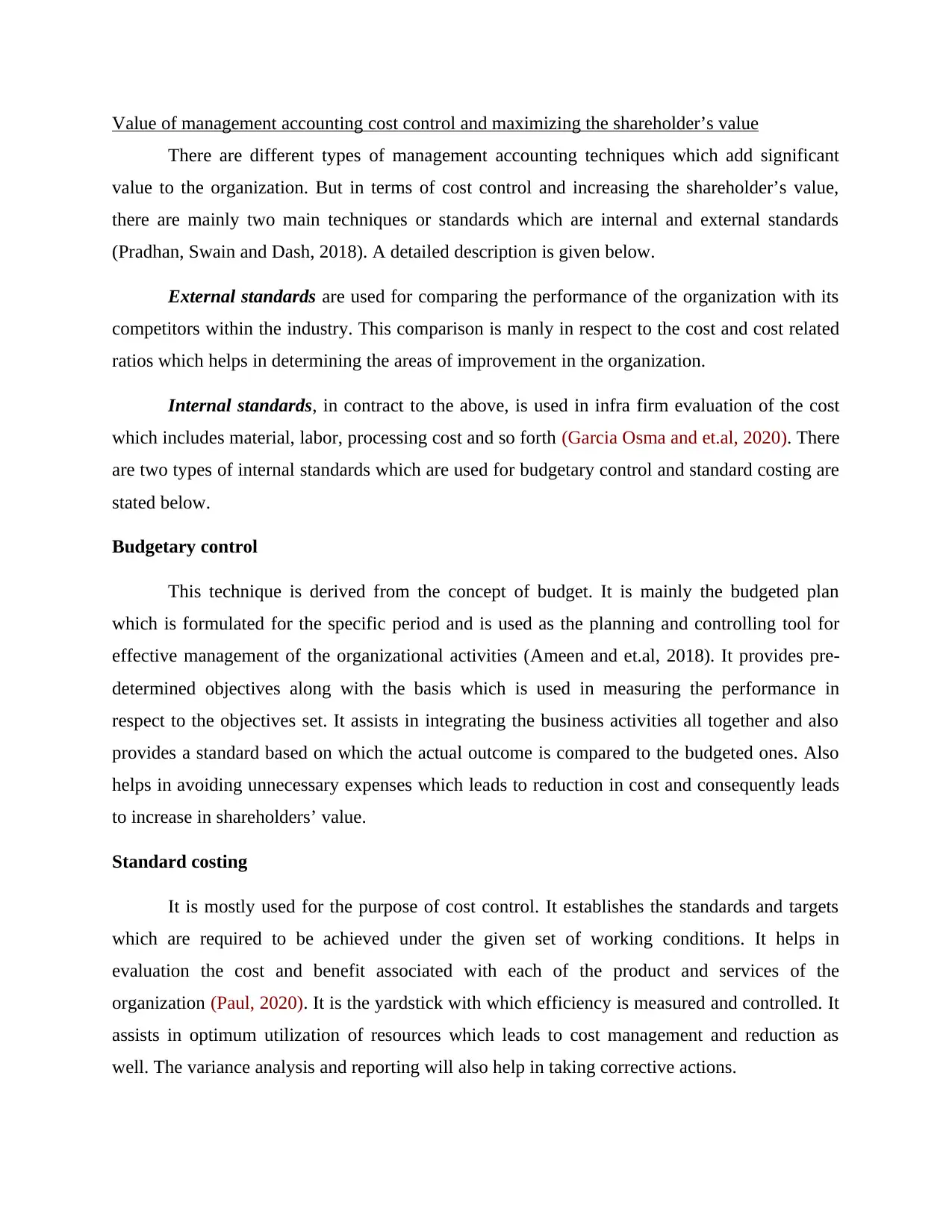
Value of management accounting cost control and maximizing the shareholder’s value
There are different types of management accounting techniques which add significant
value to the organization. But in terms of cost control and increasing the shareholder’s value,
there are mainly two main techniques or standards which are internal and external standards
(Pradhan, Swain and Dash, 2018). A detailed description is given below.
External standards are used for comparing the performance of the organization with its
competitors within the industry. This comparison is manly in respect to the cost and cost related
ratios which helps in determining the areas of improvement in the organization.
Internal standards, in contract to the above, is used in infra firm evaluation of the cost
which includes material, labor, processing cost and so forth (Garcia Osma and et.al, 2020). There
are two types of internal standards which are used for budgetary control and standard costing are
stated below.
Budgetary control
This technique is derived from the concept of budget. It is mainly the budgeted plan
which is formulated for the specific period and is used as the planning and controlling tool for
effective management of the organizational activities (Ameen and et.al, 2018). It provides pre-
determined objectives along with the basis which is used in measuring the performance in
respect to the objectives set. It assists in integrating the business activities all together and also
provides a standard based on which the actual outcome is compared to the budgeted ones. Also
helps in avoiding unnecessary expenses which leads to reduction in cost and consequently leads
to increase in shareholders’ value.
Standard costing
It is mostly used for the purpose of cost control. It establishes the standards and targets
which are required to be achieved under the given set of working conditions. It helps in
evaluation the cost and benefit associated with each of the product and services of the
organization (Paul, 2020). It is the yardstick with which efficiency is measured and controlled. It
assists in optimum utilization of resources which leads to cost management and reduction as
well. The variance analysis and reporting will also help in taking corrective actions.
There are different types of management accounting techniques which add significant
value to the organization. But in terms of cost control and increasing the shareholder’s value,
there are mainly two main techniques or standards which are internal and external standards
(Pradhan, Swain and Dash, 2018). A detailed description is given below.
External standards are used for comparing the performance of the organization with its
competitors within the industry. This comparison is manly in respect to the cost and cost related
ratios which helps in determining the areas of improvement in the organization.
Internal standards, in contract to the above, is used in infra firm evaluation of the cost
which includes material, labor, processing cost and so forth (Garcia Osma and et.al, 2020). There
are two types of internal standards which are used for budgetary control and standard costing are
stated below.
Budgetary control
This technique is derived from the concept of budget. It is mainly the budgeted plan
which is formulated for the specific period and is used as the planning and controlling tool for
effective management of the organizational activities (Ameen and et.al, 2018). It provides pre-
determined objectives along with the basis which is used in measuring the performance in
respect to the objectives set. It assists in integrating the business activities all together and also
provides a standard based on which the actual outcome is compared to the budgeted ones. Also
helps in avoiding unnecessary expenses which leads to reduction in cost and consequently leads
to increase in shareholders’ value.
Standard costing
It is mostly used for the purpose of cost control. It establishes the standards and targets
which are required to be achieved under the given set of working conditions. It helps in
evaluation the cost and benefit associated with each of the product and services of the
organization (Paul, 2020). It is the yardstick with which efficiency is measured and controlled. It
assists in optimum utilization of resources which leads to cost management and reduction as
well. The variance analysis and reporting will also help in taking corrective actions.
⊘ This is a preview!⊘
Do you want full access?
Subscribe today to unlock all pages.

Trusted by 1+ million students worldwide
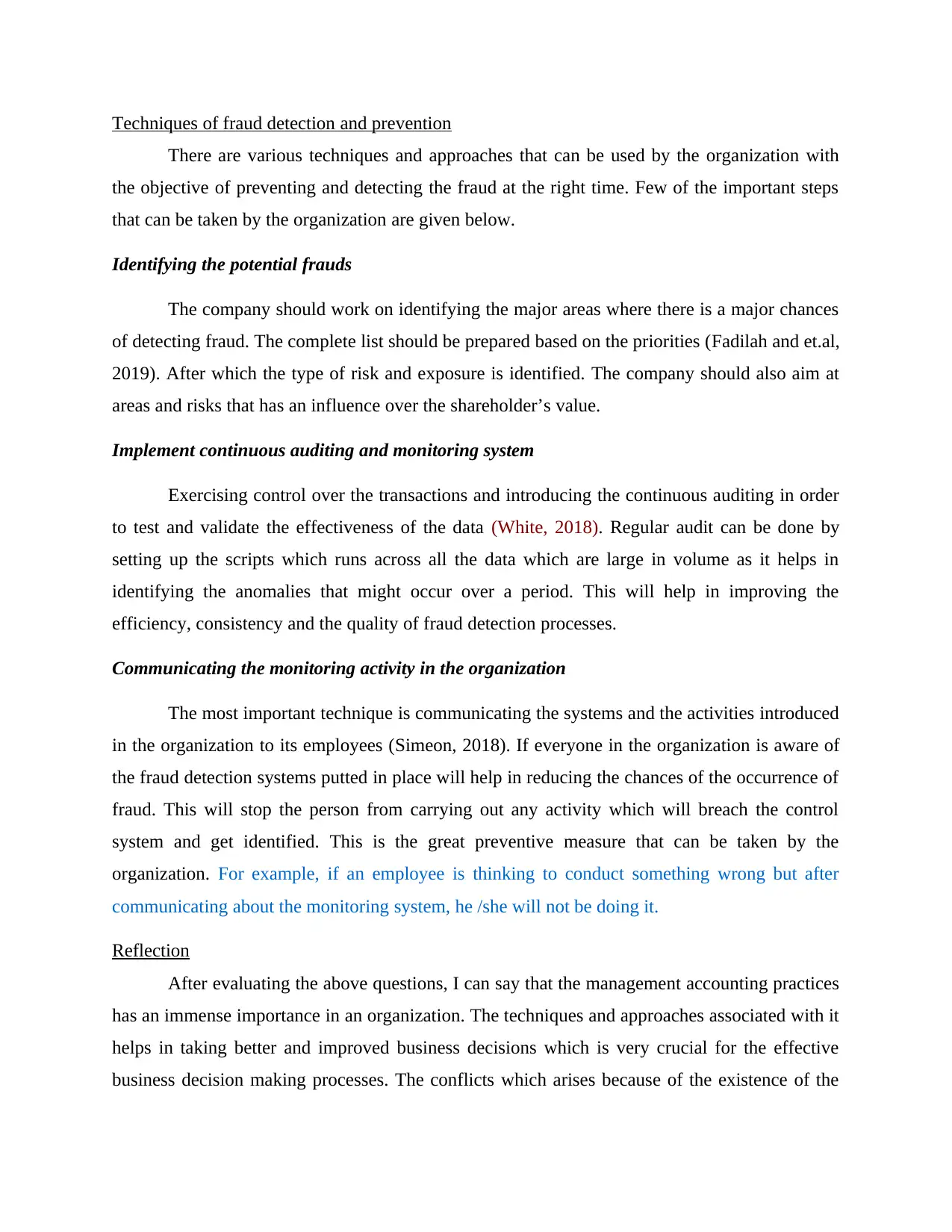
Techniques of fraud detection and prevention
There are various techniques and approaches that can be used by the organization with
the objective of preventing and detecting the fraud at the right time. Few of the important steps
that can be taken by the organization are given below.
Identifying the potential frauds
The company should work on identifying the major areas where there is a major chances
of detecting fraud. The complete list should be prepared based on the priorities (Fadilah and et.al,
2019). After which the type of risk and exposure is identified. The company should also aim at
areas and risks that has an influence over the shareholder’s value.
Implement continuous auditing and monitoring system
Exercising control over the transactions and introducing the continuous auditing in order
to test and validate the effectiveness of the data (White, 2018). Regular audit can be done by
setting up the scripts which runs across all the data which are large in volume as it helps in
identifying the anomalies that might occur over a period. This will help in improving the
efficiency, consistency and the quality of fraud detection processes.
Communicating the monitoring activity in the organization
The most important technique is communicating the systems and the activities introduced
in the organization to its employees (Simeon, 2018). If everyone in the organization is aware of
the fraud detection systems putted in place will help in reducing the chances of the occurrence of
fraud. This will stop the person from carrying out any activity which will breach the control
system and get identified. This is the great preventive measure that can be taken by the
organization. For example, if an employee is thinking to conduct something wrong but after
communicating about the monitoring system, he /she will not be doing it.
Reflection
After evaluating the above questions, I can say that the management accounting practices
has an immense importance in an organization. The techniques and approaches associated with it
helps in taking better and improved business decisions which is very crucial for the effective
business decision making processes. The conflicts which arises because of the existence of the
There are various techniques and approaches that can be used by the organization with
the objective of preventing and detecting the fraud at the right time. Few of the important steps
that can be taken by the organization are given below.
Identifying the potential frauds
The company should work on identifying the major areas where there is a major chances
of detecting fraud. The complete list should be prepared based on the priorities (Fadilah and et.al,
2019). After which the type of risk and exposure is identified. The company should also aim at
areas and risks that has an influence over the shareholder’s value.
Implement continuous auditing and monitoring system
Exercising control over the transactions and introducing the continuous auditing in order
to test and validate the effectiveness of the data (White, 2018). Regular audit can be done by
setting up the scripts which runs across all the data which are large in volume as it helps in
identifying the anomalies that might occur over a period. This will help in improving the
efficiency, consistency and the quality of fraud detection processes.
Communicating the monitoring activity in the organization
The most important technique is communicating the systems and the activities introduced
in the organization to its employees (Simeon, 2018). If everyone in the organization is aware of
the fraud detection systems putted in place will help in reducing the chances of the occurrence of
fraud. This will stop the person from carrying out any activity which will breach the control
system and get identified. This is the great preventive measure that can be taken by the
organization. For example, if an employee is thinking to conduct something wrong but after
communicating about the monitoring system, he /she will not be doing it.
Reflection
After evaluating the above questions, I can say that the management accounting practices
has an immense importance in an organization. The techniques and approaches associated with it
helps in taking better and improved business decisions which is very crucial for the effective
business decision making processes. The conflicts which arises because of the existence of the
Paraphrase This Document
Need a fresh take? Get an instant paraphrase of this document with our AI Paraphraser
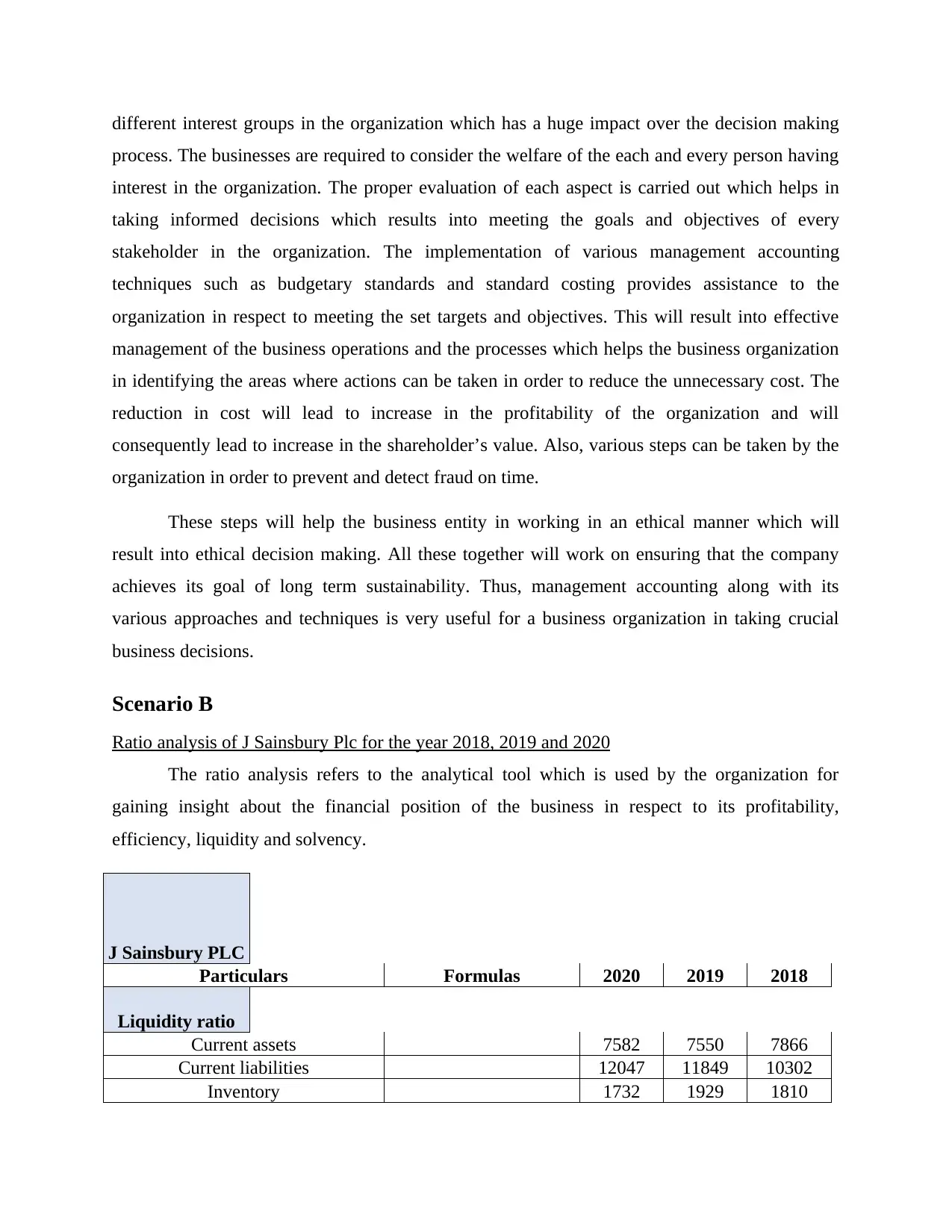
different interest groups in the organization which has a huge impact over the decision making
process. The businesses are required to consider the welfare of the each and every person having
interest in the organization. The proper evaluation of each aspect is carried out which helps in
taking informed decisions which results into meeting the goals and objectives of every
stakeholder in the organization. The implementation of various management accounting
techniques such as budgetary standards and standard costing provides assistance to the
organization in respect to meeting the set targets and objectives. This will result into effective
management of the business operations and the processes which helps the business organization
in identifying the areas where actions can be taken in order to reduce the unnecessary cost. The
reduction in cost will lead to increase in the profitability of the organization and will
consequently lead to increase in the shareholder’s value. Also, various steps can be taken by the
organization in order to prevent and detect fraud on time.
These steps will help the business entity in working in an ethical manner which will
result into ethical decision making. All these together will work on ensuring that the company
achieves its goal of long term sustainability. Thus, management accounting along with its
various approaches and techniques is very useful for a business organization in taking crucial
business decisions.
Scenario B
Ratio analysis of J Sainsbury Plc for the year 2018, 2019 and 2020
The ratio analysis refers to the analytical tool which is used by the organization for
gaining insight about the financial position of the business in respect to its profitability,
efficiency, liquidity and solvency.
J Sainsbury PLC
Particulars Formulas 2020 2019 2018
Liquidity ratio
Current assets 7582 7550 7866
Current liabilities 12047 11849 10302
Inventory 1732 1929 1810
process. The businesses are required to consider the welfare of the each and every person having
interest in the organization. The proper evaluation of each aspect is carried out which helps in
taking informed decisions which results into meeting the goals and objectives of every
stakeholder in the organization. The implementation of various management accounting
techniques such as budgetary standards and standard costing provides assistance to the
organization in respect to meeting the set targets and objectives. This will result into effective
management of the business operations and the processes which helps the business organization
in identifying the areas where actions can be taken in order to reduce the unnecessary cost. The
reduction in cost will lead to increase in the profitability of the organization and will
consequently lead to increase in the shareholder’s value. Also, various steps can be taken by the
organization in order to prevent and detect fraud on time.
These steps will help the business entity in working in an ethical manner which will
result into ethical decision making. All these together will work on ensuring that the company
achieves its goal of long term sustainability. Thus, management accounting along with its
various approaches and techniques is very useful for a business organization in taking crucial
business decisions.
Scenario B
Ratio analysis of J Sainsbury Plc for the year 2018, 2019 and 2020
The ratio analysis refers to the analytical tool which is used by the organization for
gaining insight about the financial position of the business in respect to its profitability,
efficiency, liquidity and solvency.
J Sainsbury PLC
Particulars Formulas 2020 2019 2018
Liquidity ratio
Current assets 7582 7550 7866
Current liabilities 12047 11849 10302
Inventory 1732 1929 1810
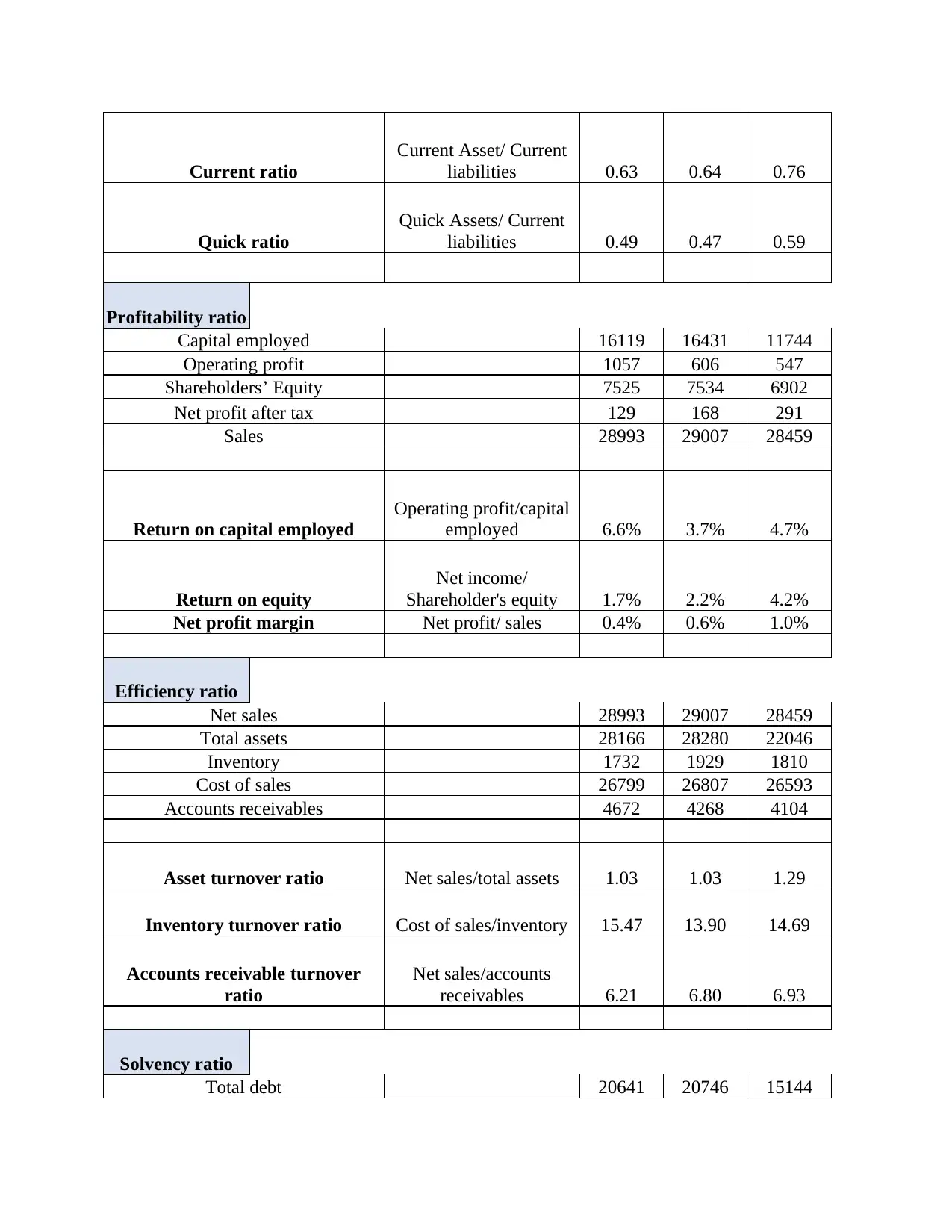
Current ratio
Current Asset/ Current
liabilities 0.63 0.64 0.76
Quick ratio
Quick Assets/ Current
liabilities 0.49 0.47 0.59
Profitability ratio
Capital employed 16119 16431 11744
Operating profit 1057 606 547
Shareholders’ Equity 7525 7534 6902
Net profit after tax 129 168 291
Sales 28993 29007 28459
Return on capital employed
Operating profit/capital
employed 6.6% 3.7% 4.7%
Return on equity
Net income/
Shareholder's equity 1.7% 2.2% 4.2%
Net profit margin Net profit/ sales 0.4% 0.6% 1.0%
Efficiency ratio
Net sales 28993 29007 28459
Total assets 28166 28280 22046
Inventory 1732 1929 1810
Cost of sales 26799 26807 26593
Accounts receivables 4672 4268 4104
Asset turnover ratio Net sales/total assets 1.03 1.03 1.29
Inventory turnover ratio Cost of sales/inventory 15.47 13.90 14.69
Accounts receivable turnover
ratio
Net sales/accounts
receivables 6.21 6.80 6.93
Solvency ratio
Total debt 20641 20746 15144
Current Asset/ Current
liabilities 0.63 0.64 0.76
Quick ratio
Quick Assets/ Current
liabilities 0.49 0.47 0.59
Profitability ratio
Capital employed 16119 16431 11744
Operating profit 1057 606 547
Shareholders’ Equity 7525 7534 6902
Net profit after tax 129 168 291
Sales 28993 29007 28459
Return on capital employed
Operating profit/capital
employed 6.6% 3.7% 4.7%
Return on equity
Net income/
Shareholder's equity 1.7% 2.2% 4.2%
Net profit margin Net profit/ sales 0.4% 0.6% 1.0%
Efficiency ratio
Net sales 28993 29007 28459
Total assets 28166 28280 22046
Inventory 1732 1929 1810
Cost of sales 26799 26807 26593
Accounts receivables 4672 4268 4104
Asset turnover ratio Net sales/total assets 1.03 1.03 1.29
Inventory turnover ratio Cost of sales/inventory 15.47 13.90 14.69
Accounts receivable turnover
ratio
Net sales/accounts
receivables 6.21 6.80 6.93
Solvency ratio
Total debt 20641 20746 15144
⊘ This is a preview!⊘
Do you want full access?
Subscribe today to unlock all pages.

Trusted by 1+ million students worldwide
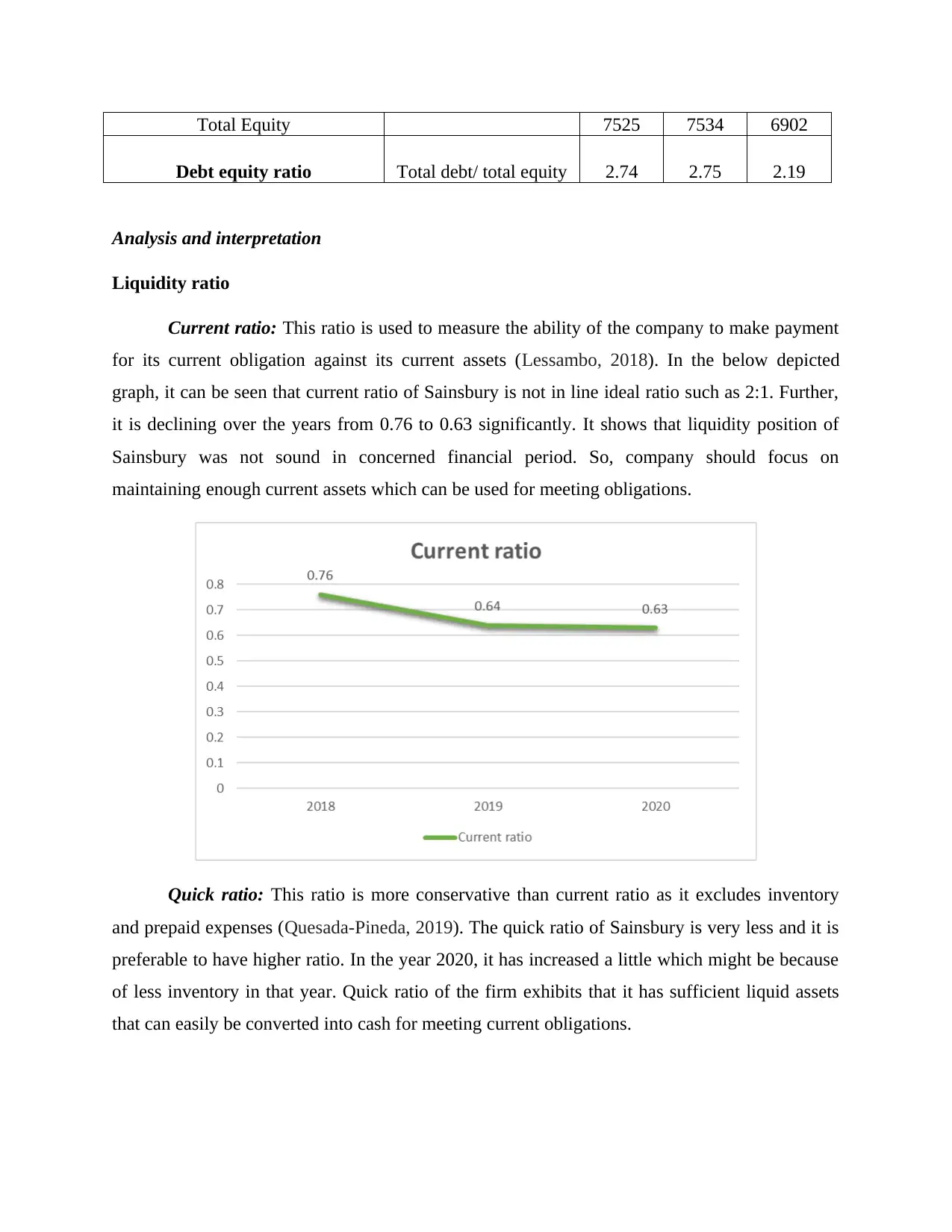
Total Equity 7525 7534 6902
Debt equity ratio Total debt/ total equity 2.74 2.75 2.19
Analysis and interpretation
Liquidity ratio
Current ratio: This ratio is used to measure the ability of the company to make payment
for its current obligation against its current assets (Lessambo, 2018). In the below depicted
graph, it can be seen that current ratio of Sainsbury is not in line ideal ratio such as 2:1. Further,
it is declining over the years from 0.76 to 0.63 significantly. It shows that liquidity position of
Sainsbury was not sound in concerned financial period. So, company should focus on
maintaining enough current assets which can be used for meeting obligations.
Quick ratio: This ratio is more conservative than current ratio as it excludes inventory
and prepaid expenses (Quesada-Pineda, 2019). The quick ratio of Sainsbury is very less and it is
preferable to have higher ratio. In the year 2020, it has increased a little which might be because
of less inventory in that year. Quick ratio of the firm exhibits that it has sufficient liquid assets
that can easily be converted into cash for meeting current obligations.
Debt equity ratio Total debt/ total equity 2.74 2.75 2.19
Analysis and interpretation
Liquidity ratio
Current ratio: This ratio is used to measure the ability of the company to make payment
for its current obligation against its current assets (Lessambo, 2018). In the below depicted
graph, it can be seen that current ratio of Sainsbury is not in line ideal ratio such as 2:1. Further,
it is declining over the years from 0.76 to 0.63 significantly. It shows that liquidity position of
Sainsbury was not sound in concerned financial period. So, company should focus on
maintaining enough current assets which can be used for meeting obligations.
Quick ratio: This ratio is more conservative than current ratio as it excludes inventory
and prepaid expenses (Quesada-Pineda, 2019). The quick ratio of Sainsbury is very less and it is
preferable to have higher ratio. In the year 2020, it has increased a little which might be because
of less inventory in that year. Quick ratio of the firm exhibits that it has sufficient liquid assets
that can easily be converted into cash for meeting current obligations.
Paraphrase This Document
Need a fresh take? Get an instant paraphrase of this document with our AI Paraphraser
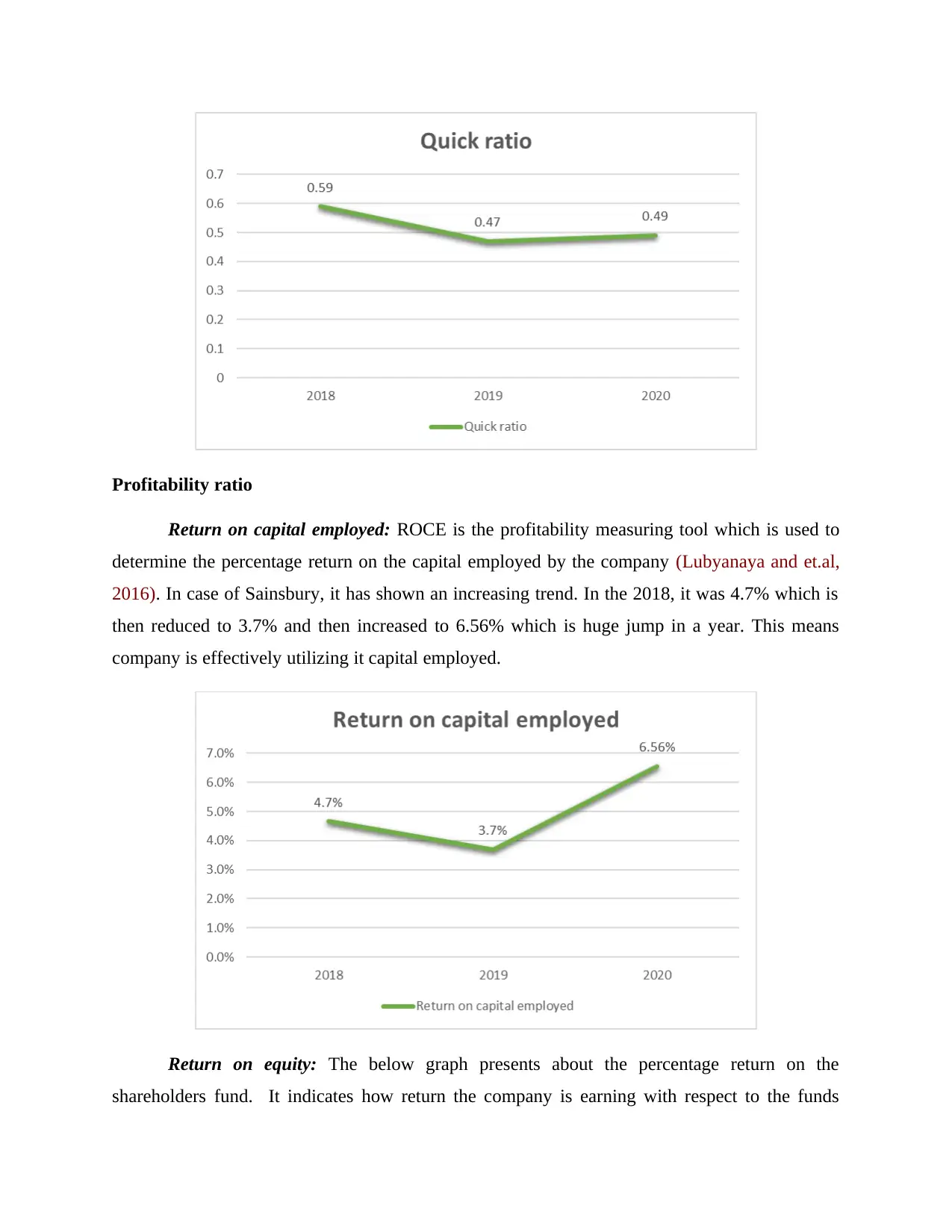
Profitability ratio
Return on capital employed: ROCE is the profitability measuring tool which is used to
determine the percentage return on the capital employed by the company (Lubyanaya and et.al,
2016). In case of Sainsbury, it has shown an increasing trend. In the 2018, it was 4.7% which is
then reduced to 3.7% and then increased to 6.56% which is huge jump in a year. This means
company is effectively utilizing it capital employed.
Return on equity: The below graph presents about the percentage return on the
shareholders fund. It indicates how return the company is earning with respect to the funds
Return on capital employed: ROCE is the profitability measuring tool which is used to
determine the percentage return on the capital employed by the company (Lubyanaya and et.al,
2016). In case of Sainsbury, it has shown an increasing trend. In the 2018, it was 4.7% which is
then reduced to 3.7% and then increased to 6.56% which is huge jump in a year. This means
company is effectively utilizing it capital employed.
Return on equity: The below graph presents about the percentage return on the
shareholders fund. It indicates how return the company is earning with respect to the funds
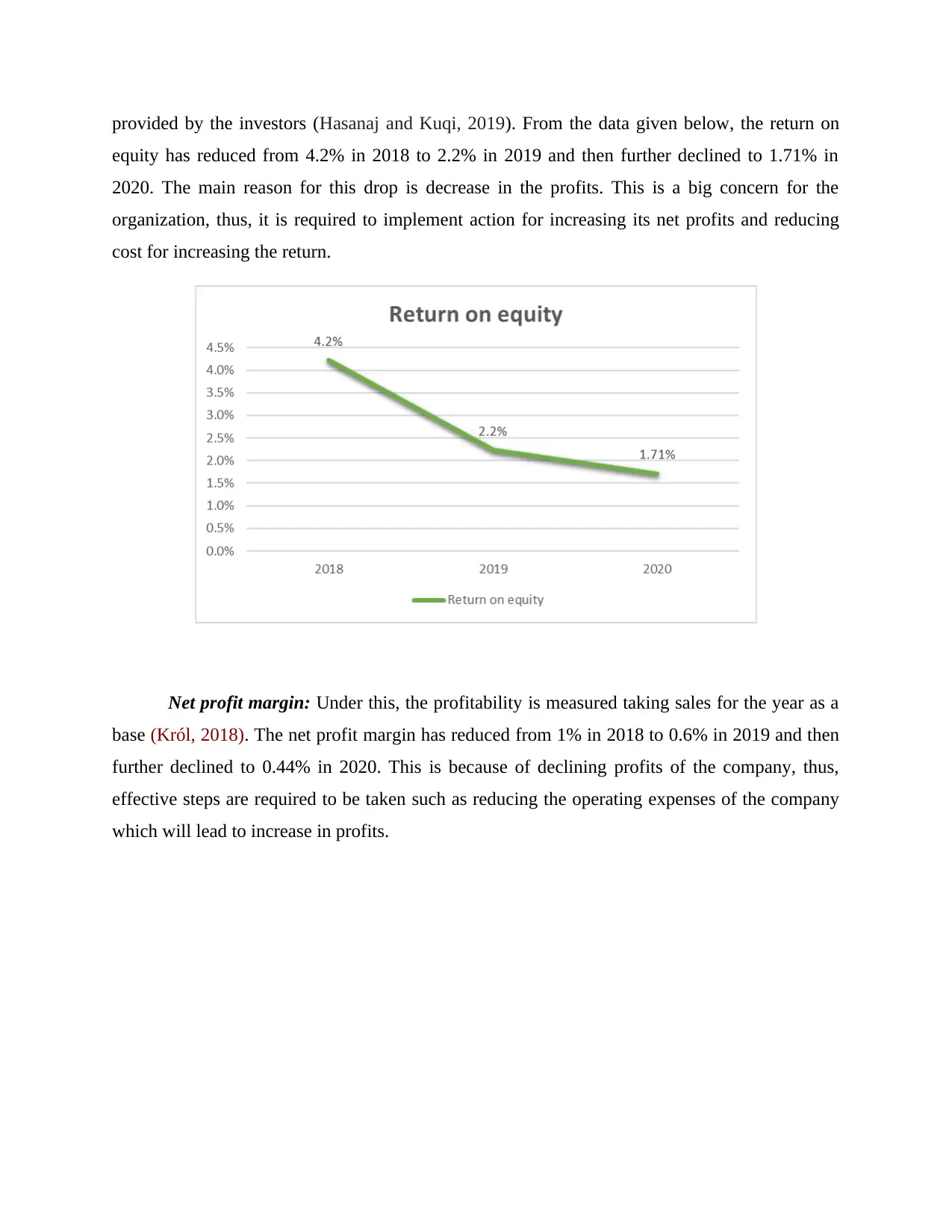
provided by the investors (Hasanaj and Kuqi, 2019). From the data given below, the return on
equity has reduced from 4.2% in 2018 to 2.2% in 2019 and then further declined to 1.71% in
2020. The main reason for this drop is decrease in the profits. This is a big concern for the
organization, thus, it is required to implement action for increasing its net profits and reducing
cost for increasing the return.
Net profit margin: Under this, the profitability is measured taking sales for the year as a
base (Król, 2018). The net profit margin has reduced from 1% in 2018 to 0.6% in 2019 and then
further declined to 0.44% in 2020. This is because of declining profits of the company, thus,
effective steps are required to be taken such as reducing the operating expenses of the company
which will lead to increase in profits.
equity has reduced from 4.2% in 2018 to 2.2% in 2019 and then further declined to 1.71% in
2020. The main reason for this drop is decrease in the profits. This is a big concern for the
organization, thus, it is required to implement action for increasing its net profits and reducing
cost for increasing the return.
Net profit margin: Under this, the profitability is measured taking sales for the year as a
base (Król, 2018). The net profit margin has reduced from 1% in 2018 to 0.6% in 2019 and then
further declined to 0.44% in 2020. This is because of declining profits of the company, thus,
effective steps are required to be taken such as reducing the operating expenses of the company
which will lead to increase in profits.
⊘ This is a preview!⊘
Do you want full access?
Subscribe today to unlock all pages.

Trusted by 1+ million students worldwide
1 out of 19
Related Documents
Your All-in-One AI-Powered Toolkit for Academic Success.
+13062052269
info@desklib.com
Available 24*7 on WhatsApp / Email
![[object Object]](/_next/static/media/star-bottom.7253800d.svg)
Unlock your academic potential
Copyright © 2020–2025 A2Z Services. All Rights Reserved. Developed and managed by ZUCOL.





